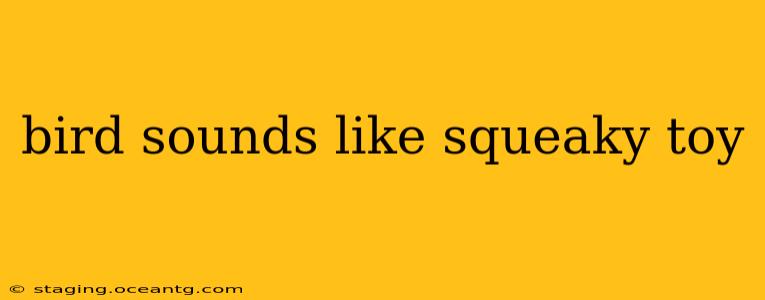Have you ever heard a bird sound eerily similar to a squeaky toy? It's a surprisingly common experience, and figuring out which feathered friend is responsible can be a fun ornithological challenge. This comprehensive guide will help you identify the culprits behind those squeaky bird sounds, explore the reasons behind such vocalizations, and offer tips for attracting these unique birds to your backyard.
What Birds Sound Like a Squeaky Toy?
Several bird species produce sounds reminiscent of squeaky toys, ranging from high-pitched whistles to rasping squeals. The exact sound varies depending on the species, its age, and the context of the vocalization. Some common suspects include:
-
House Wrens: These tiny, energetic birds are known for their complex and varied songs, often including high-pitched, buzzy, and even squeaky notes. Their song is a fast-paced series of trills, chirps, and whistles, often containing sounds that resemble a child's squeaky toy.
-
Chickadees: Certain chickadee calls, especially alarm calls or contact calls between individuals, can sound surprisingly squeaky. These calls are often short, sharp, and high-pitched.
-
Some species of Sparrows: While sparrows are known for their more typical chirping, some species, depending on their location and individual vocalizations, might include squeaky notes in their repertoire.
-
Young birds: It's important to note that many young birds, before they fully develop their adult vocalizations, often produce high-pitched, slightly squeaky chirps as they beg for food from their parents. This is less about species and more about a developmental stage.
Why Do Birds Make Squeaky Sounds?
The reason behind squeaky bird sounds varies depending on the species and the situation. Generally, these sounds serve several vital purposes:
-
Attracting mates: High-pitched squeaks can be effective for attracting potential mates, especially in dense vegetation where lower-frequency sounds might be muffled.
-
Territorial defense: Squeaky calls can be used to warn off intruders from a bird's territory. The intensity and frequency of the squeaks might vary depending on the perceived threat level.
-
Contact calls: Birds use squeaky sounds to maintain contact with their flock or family members, especially in areas with dense foliage.
-
Alarm calls: A sudden, sharp squeaking sound might indicate that the bird has detected a predator and is trying to alert others.
How to Identify the Squeaky Bird
Pinpointing the exact bird behind the squeaking sound can be tricky, but here are some helpful tips:
- Pay attention to the context: Where did you hear the sound? Was it in a forest, a backyard, or a park? This can narrow down the possibilities.
- Listen to the entire vocalization: Don't focus only on the squeaky part; listen to the whole song or call to get a better idea of the bird's identity.
- Use a bird identification app: Several excellent apps, such as Merlin Bird ID, can help you identify birds based on their songs and calls. Many apps have sound recognition features.
- Observe the bird: If possible, try to see the bird making the sound. This will make identification much easier.
What If I Want to Attract Squeaky Birds to My Yard?
If you enjoy the sound of squeaky birds and want to attract them to your backyard, consider these measures:
- Provide a natural habitat: Plant native trees, shrubs, and flowers to provide food and shelter.
- Offer a water source: Birds need a clean water source for drinking and bathing.
- Avoid using pesticides: Pesticides can harm birds and reduce their numbers.
- Install bird feeders: Offer high-quality birdseed to attract a variety of species.
This guide provides a comprehensive overview of birds that may sound like a squeaky toy. Remember that accurate identification often requires careful listening and observation. Happy birdwatching!
